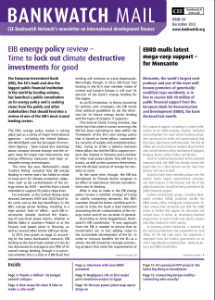Europe’s PPP crisis – European Commission and EIB magic up the ‘project bonds’ elixir

Bankwatch Mail | 14 December 2012
Although public authorities appear increasingly to be turning their backs on public-private partnerships (PPPs) for delivery of services and the provision of infrastructure, the beleaguered investment vehicle continues to be aggressively promoted by the European Commission and the European Investment Bank (EIB). An official in-depth evaluation of this financing model, however, remains long overdue.

This article is from Issue 54 of our quarterly newsletter Bankwatch Mail
Browse all articles on the right
The EIB has recently published a market update for PPPs in Europe for the first half of 2012 (pdf). The update shows that during this period the European PPP market recorded its lowest volume for ten years: only seven EU states closed PPP deals during the first six months of this year, with the UK signing most contracts (16) but France, with 11 projects worth a total of EUR 2.9 billion, remaining the largest PPP market in terms of volume.
Bankwatch has long been critical of PPP models of infrastructure financing, based on a fair amount of evidence of PPPs that have failed to deliver positive results in central and eastern Europe. Thus, fresh data from the EIB itself that more and more EU governments are deciding not to ‘build now and pay heavily later‘ is in many ways positive news.

Not a silver bullet for public infrastructure. Our website Overpriced and underwritten exposes the hidden costs of public-private partnerships.
All the same, the EIB’s findings do raise the question of what is going on – why are there fewer PPP projects being signed of late?
Are PPPs simply another victim of the ongoing economic crisis? Or have governments finally started to take heed of warnings issued by PPP critics for well over a decade now? Unfortunately the EIB’s update offers no answers to these questions.
However, another recently published EIB document (pdf) does comment that:
“Since the onset of the financial crisis, commercial bank debt has become more difficult to secure and lending terms (e.g. pricing, tenors, loan volumes) have deteriorated significantly, affecting the bankability and value for money of PPP projects.”
It is undeniable that the crisis since autumn 2008 has hit PPPs hard, as the example of the M25 motorway widening in the UK – an EIB backed project – shows. The UK National Audit Office found that the price of the contract increased by approximately EUR 826 million to roughly EUR 4.25 billion between the time when Connect Plus became preferred bidder and the contract letting in May 2009.
Financing terms for the M25 project were much more expensive than before the credit crisis and accounted for 67 percent of this price increase. While this project did – controversially – go ahead, many other PPP projects caught up in the crisis backwash did not.
One of the answers to the emerging ‘PPP crisis’, according to the European Commission, is the Project Bonds Initiative, in which the EIB will play a role by guaranteeing bonds issued for PPPs in EU member states. Last month, Commissioner Olli Rehn and EIB President Werner Hoyer presented project bonds at an event marking the signing of the cooperation agreement between the EIB and the Commission to establish the pilot phase of the initiative.
But project bonds are the answer to the wrong question. Instead of asking how to finance more PPPs, and helping private companies to transfer even more of their risks onto the public sector, the EU institutions should be taking a long, hard look at whether to finance more PPPs at all and, if so, under what conditions.
The Commission and the EIB have not shown any inclination to undertake this kind of in-depth and critical evaluation of PPPs so far, although around the EU the evidence is becoming ever stronger that PPPs are a risky model for governments to follow. Reliance on them is – believe it or not – resulting in mammoth, long-term budget burdens. Just look at Hungary, Portugal and the UK as the most noticeable PPP-binging casualties.
Instead of properly diagnosing the problem, though, the Commission and the EIB prefer to keep on magicking up elixirs to sustain a far from miraculous investment model. Project bonds may be able to prop up PPP investments in the short term, but how many rabbits can European authorities continue to pull out of the hat – when the hat is falling apart?
Read more
Bankwatch’s ground-breaking analysis of IFI-backed PPP projects in central and eastern Europe is available at:
https://bankwatch.org/documents/never_mind_the_balance_sheet.pdf
Theme: Social & economic impacts
Tags: BW Mail 54
Never miss an update
We expose the risks of international public finance and bring critical updates from the ground. We believe that the billions of public money should work for people and the environment.
STAY INFORMED
